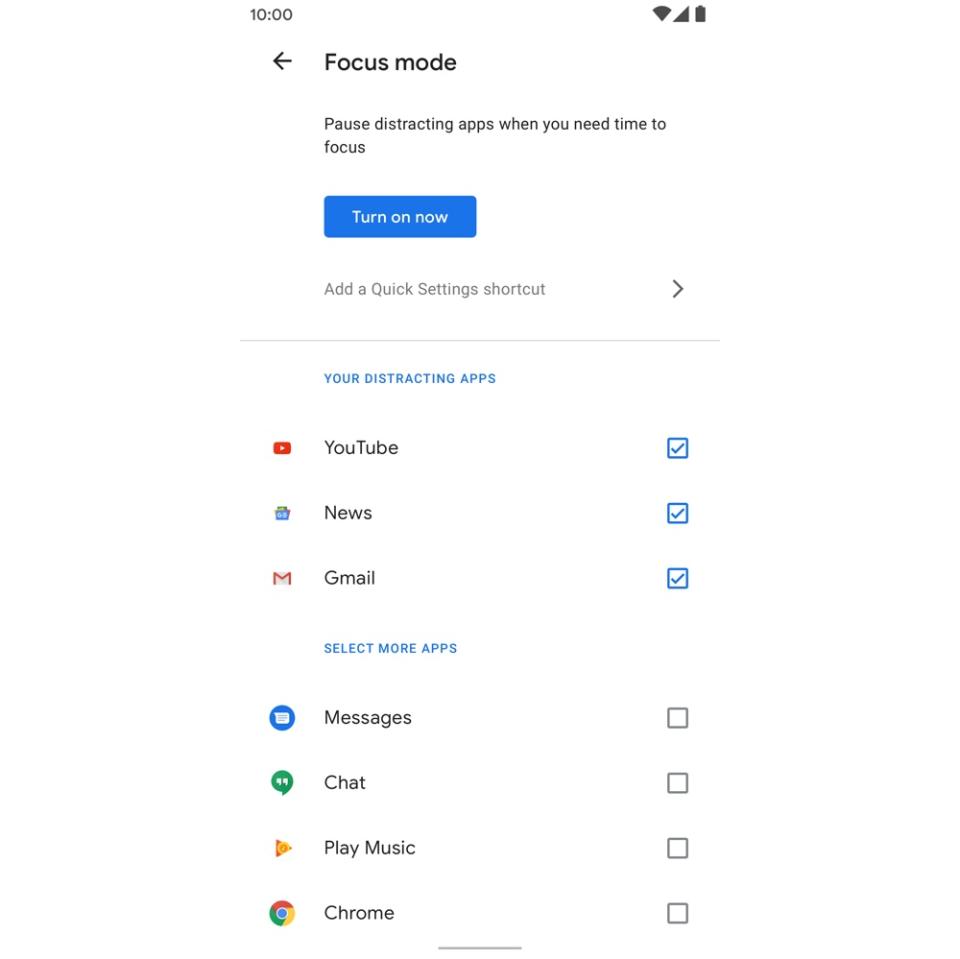Google’s new Android Focus Mode could break your app addictions

I have an unhealthy addiction to a number of apps on my smartphone. I’m talking about the kind of addiction that causes my fingers to seemingly move on their own to unlock my phone, then mindlessly scroll through social media apps for large chunks of time regardless of where I am.
I’m clearly not the only person with this kind of addiction — Google (GOOG, GOOGL) is rolling out a new feature called Focus Mode as part of its Digital Wellbeing suite to get help users get this kind of behavior under control.
Available as part of Google’s upcoming Android 10 update, and Android P, and currently in beta, Focus Mode is designed to make you stop using hyper-distracting apps, and let you focus on more important things like work and family.
An addiction to scrolling
Focus Mode, which is accessible via the Digital Wellbeing option in the Android Settings menu, is akin to a teacher taking away a distracting toy from a student until the school day is over. The feature lets you not only turn off notifications for apps that you find overly distracting — for me that’s Instagram (FB) — but make them virtually inaccessible for a set period of time, as well.
Google’s Rose La Prairie, product manager for Digital Wellbeing, says her London-based team worked to make Focus Mode feel more like a means for users to take back control of their lives from their smartphones.
It sounds like a ridiculous statement, but according to La Prairie’s team, more and more users feel as though their devices are rectangular dictators ordering them around, rather than a means to access content and keep in touch with friends, family, and coworkers.
It doesn’t help that apps like workplace messenger Slack (WORK), and the like, are purpose-built for use on smartphones, making it difficult to disconnect from the office, even while at home with family.
Then there are apps like Instagram, Facebook, Twitter (TWTR), and others that are meant to keep you scrolling for as long as possible, so they can serve up ads based on your interactions.

La Prairie explained that some users have told the Digital Wellbeing team about how much they enjoy flying, simply because it gives them a chance to disconnect and talk with their spouses without being interrupted by their devices.
Focus Mode simulates that kind of experience by letting you suspend specific apps entirely. You do this by selecting which app you want to suspend in the Focus Mode menu. When an app is suspended, its icon will appear greyed out on your home screen or app drawer.
If you try accessing the app while it’s greyed out, you’ll get a reminder telling you that you used Focus Mode to disable it. The idea is to give you an extra friction point that will make you pause before opening the app, which will, hopefully, keep you from switching off Focus Mode until it’s appropriate to use the app you turned off again.
You can blow past the Focus Mode warning and get right to scrolling aimlessly again, or replying to messages at the dinner table, but the feature will at least make you think twice about doing so.
A change in how we use smartphones
Google’s Digital Wellbeing and Apple’s (AAPL) Screen Time are part of a new crop of features meant to keep users’ smartphones from taking over their lives. Whether it’s games, social media apps, YouTube, or simply browsing the web, consumers are using their smartphones more than ever.
According to research firm eMarketer, the average U.S. adult will spend 3 hours and 43 minutes per day on their mobile devices in 2019. That will mark the first time mobile device usage will eclipse time spent watching TV.
And by 2021, that difference will only increase, with consumers expected to spend 3 hours and 54 minutes per day on their smartphones compared to 3 hours and 22 minutes per day watching TV.
In developing Google’s Digital Wellbeing suite, La Prairie said that the team didn’t want to shame users or make them feel bad for feeling like their phones are controlling them. As a result, the team chose not to use any red markings, which is why the app specifically uses blue and white as its main colors.
Focus Mode will be available to Android 10 users when the operating system update rolls out in the coming weeks. I, for one, and going to give it a shot to see if I can break my habit of brainlessly scrolling Instagram. Here’s hoping it works.
More from Dan:
The biggest differences between Apple's new credit card and most other cards
Fitbit debuts premium fitness and health tracking service as part of turnaround
Samsung’s Galaxy Note10+ is a big-screen powerhouse with a big price tag
Email Daniel Howley at [email protected]; follow him on Twitter at @DanielHowley.
Follow Yahoo Finance on Twitter, Facebook, Instagram, Flipboard, SmartNews, LinkedIn,YouTube, and reddit.

